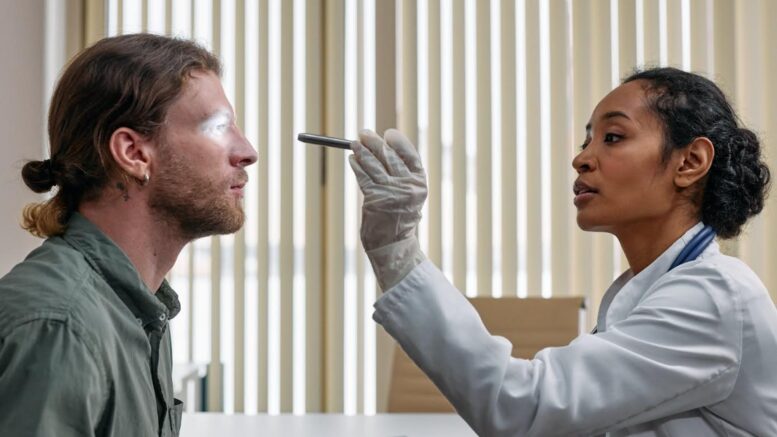As we age, it is common for vision to worsen. While certain risk factors like age are beyond our control, there are proactive measures we can take to lower the risk of developing cataracts or delay their onset. In this article, we will explore six effective ways to reduce your risk of cataracts and maintain good eye health.
Understanding Cataracts
What are cataracts? Cataracts are the clouding of the eye’s natural lens, which is normally clear. It can significantly impair vision and hinder daily activities. As a prevalent age-related condition, understanding how to reduce the risk of developing cataracts is crucial. Start by researching various strategies to lower your risk of cataracts. For instance, incorporating simple lifestyle changes can contribute to maintaining clear vision and overall eye health.
1. Maintain a Balanced Diet
A nutritious diet plays a pivotal role in promoting eye health and warding off cataracts. Foods rich in antioxidants, particularly vitamins C and E, can protect the eyes from oxidative stress. Citrus fruits, berries, nuts, and green leafy vegetables are excellent sources of these essential nutrients. Additionally, omega-3 fatty acids found in fish like salmon and trout contribute to overall eye health. Including a variety of colorful fruits and vegetables in your diet can provide a spectrum of nutrients beneficial for your eyes.
2. Protect Your Eyes from UV Rays
Prolonged exposure to ultraviolet (UV) rays can accelerate the formation of cataracts. Wearing sunglasses that block 100% of UVA and UVB rays can significantly reduce the risk. Opt for sunglasses that cover the entire eye area and choose a wide-brimmed hat for added protection against direct sunlight. By shielding your eyes from harmful UV rays, you not only decrease the likelihood of developing cataracts but also minimize the risk of other UV-related eye conditions. Remember, these preventive measures are especially important during peak sunlight hours.
3. Quit Smoking
Smoking has been consistently linked to an increased risk of cataracts. The harmful chemicals in tobacco smoke can adversely affect the lens of the eye, leading to clouding and reduced visual acuity. Quitting smoking not only benefits your overall health but also contributes to preserving the clarity of your vision. If you’re struggling to quit, consider seeking support from smoking cessation programs or healthcare professionals to increase your chances of success. Furthermore, replacing smoking habits with healthier alternatives, such as engaging in regular physical activity or practicing stress-relief techniques, can further support your journey to a smoke-free life.
4. Control Diabetes and Manage Other Health Conditions
Cataracts are more prevalent among individuals with diabetes. Keeping your blood sugar levels within a healthy range is essential to prevent various complications, including eye-related issues. Regular medical check-ups, a well-balanced diet, and regular exercise can aid in diabetes management. Moreover, controlling conditions such as hypertension can contribute to maintaining optimal eye health. By actively managing these health factors, you can lower your risk of developing cataracts and promote overall well-being.
5. Stay Hydrated
Adequate hydration is vital for maintaining the health of various body tissues, including the eyes. Dehydration can contribute to the development of cataracts, emphasizing the importance of staying well-hydrated. Aim to drink at least eight glasses of water a day and increase your intake in hot or dry climates. Proper hydration supports the eye’s natural processes, helping to prevent the clouding that characterizes cataracts. Additionally, incorporating water-rich foods into your diet, such as cucumbers and watermelon, can contribute to overall hydration and further support eye health.
6. Regular Eye Check-ups
Routine eye examinations are crucial for detecting early signs of cataracts and other eye conditions. A comprehensive eye exam can identify changes in the lens’s transparency and allow for timely intervention. Early detection enables healthcare professionals to recommend appropriate measures to slow down the progression of cataracts. Schedule regular eye check-ups, especially as you age, to ensure any emerging issues are addressed promptly. Furthermore, discuss your family history of eye conditions with your provider, as genetic factors can influence your predisposition to cataracts and other vision-related issues.
Safeguarding Your Vision
Preserving clear vision and minimizing the risk of cataracts involves adopting a proactive approach to eye health. From maintaining a nutrient-rich diet to protecting your eyes from harmful UV rays, these strategies can significantly contribute to reducing the likelihood of developing cataracts. Moreover, consider wearing blue-light-blocking glasses when using digital devices for prolonged periods to mitigate potential eye strain and protect against early-onset cataracts. Engaging in regular physical exercise, such as walking or jogging, can also promote overall cardiovascular health, indirectly benefiting your eyes and lowering the risk of cataracts.By incorporating these practices into your lifestyle and staying vigilant with regular eye check-ups, you can take meaningful steps towards safeguarding your vision for years to come.
